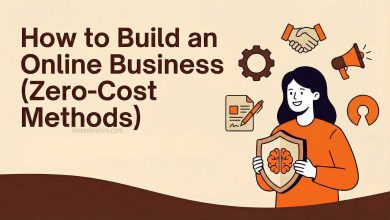How To Become an Online Marketplace Seller ? : Comprehensive Guide 2025
Online Marketplace Seller : The rise of e-commerce has opened vast opportunities for individuals and businesses to sell products online. Whether you are an entrepreneur looking to start a new business or an established retailer aiming to expand your reach, becoming an online marketplace seller can be a lucrative venture.
Table of Contents
This guide outlines the essential steps to successfully launch and grow your online selling business.
1. Choose the Right Marketplace

Selecting the appropriate online marketplace is crucial to your success. Different platforms cater to various types of products and audiences. Some popular options include:
- Amazon – Ideal for a wide range of products with extensive customer reach.
- eBay – Suitable for both new and second-hand items.
- Etsy – Focuses on handmade, vintage, and unique products.
- Shopify – Allows for personalized online store creation.
- Flipkart, Meesho, and Snapdeal – Popular choices in India.
Research the fees, policies, and audience demographics of each marketplace before deciding where to list your products.
2. Identify Your Niche and Products
A successful online business starts with the right product selection.
Also Read : How To Start Automated Print-on-Demand Stores : Make Money Online
Conduct market research to understand consumer demand, competition, and pricing trends. Consider factors like:
- Profit margins
- Supplier availability
- Shipping feasibility
- Product uniqueness
Selling trending products or those with consistent demand can improve your chances of success.
3. Register and Set Up Your Seller Account
Once you have chosen your marketplace, register as a seller by providing the necessary details:
- Business name and contact details
- Tax and bank account information
- Identity and address proof (varies by platform)
- GST registration (if applicable)
After registration, customize your seller profile with a professional logo, branding, and a compelling business description.
4. Source Your Products
Depending on your business model, you can source products through:
- Manufacturers – Directly buy from factories for better pricing.
- Wholesalers – Purchase bulk inventory at discounted rates.
- Dropshipping – Partner with suppliers who handle inventory and shipping.
- Handmade production – Create your own unique products.
Ensure quality control and maintain a reliable supply chain to avoid stock shortages and customer dissatisfaction.
5. List Your Products Effectively
Product listings play a significant role in attracting customers. Follow these best practices:
- Use high-quality images with multiple angles.
- Write detailed, SEO-friendly descriptions with keywords.
- Highlight product features, benefits, and specifications.
- Offer competitive pricing and discounts.
- Set accurate shipping and return policies.
6. Manage Orders and Fulfillment

Efficient order fulfillment enhances customer satisfaction. Marketplaces offer different fulfillment methods:
- Self-fulfillment – You handle packing and shipping.
- Marketplace fulfillment (e.g., Fulfillment by Amazon – FBA) – The marketplace stores, packs, and ships products.
- Third-party logistics (3PL) – Outsource fulfillment to a logistics provider.
Promptly update inventory levels and process orders to avoid cancellations and negative reviews.
7. Market and Promote Your Store
To attract more buyers, leverage different marketing strategies:
- Marketplace advertising – Use sponsored ads and promotions.
- Social media marketing – Promote your store on platforms like Facebook, Instagram, and Pinterest.
- SEO and content marketing – Optimize listings and create engaging content.
- Email marketing – Engage with past buyers and offer discounts.
Offering bundle deals, seasonal discounts, and loyalty programs can also drive more sales.
8. Provide Excellent Customer Service
Customer satisfaction is key to long-term success. Ensure:
- Quick response to inquiries
- Hassle-free returns and refunds
- High-quality packaging and timely deliveries
- Encouragement of positive reviews and ratings
Handling disputes professionally and proactively addressing customer concerns builds trust and brand credibility.
9. Monitor Performance and Optimize
Regularly analyze sales data and customer feedback to improve your business. Track:
- Best-selling products
- Customer demographics and preferences
- Conversion rates and traffic sources
- Return rates and common issues
Using marketplace analytics and third-party tools can help refine your strategies and maximize profits.
10. Scale Your Business
Once you establish a steady sales flow, consider expanding:
- Sell on multiple marketplaces to increase reach.
- Launch your own website for direct customer engagement.
- Introduce new product lines based on market trends.
- Automate inventory and order management using software tools.
Scaling requires careful planning, investment, and adapting to changing market demands.
Online Marketplace Seller – Conclusion :

Becoming a successful online marketplace seller requires strategic planning, quality product selection, effective marketing, and excellent customer service.
Buy Now : Ecommerce Website With 100 Products
By following these steps and continuously optimizing your business, you can build a profitable e-commerce venture and achieve long-term growth.



